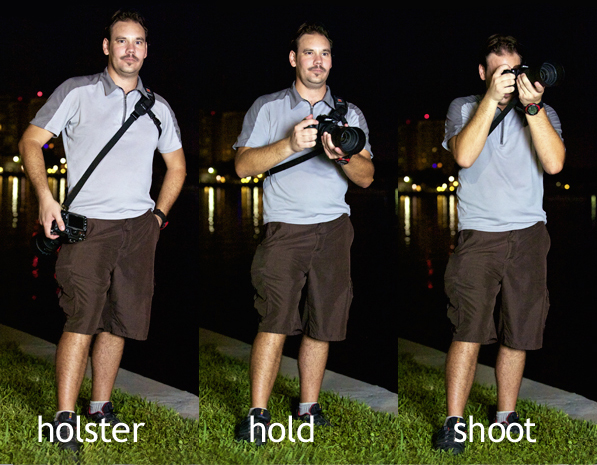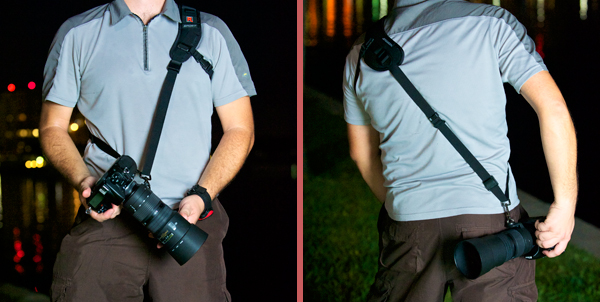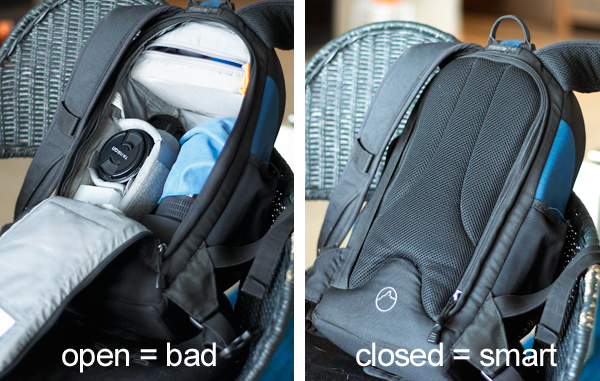
gear

 Gunslinger hip to eye shooting style demonstration using the BlackRapid RS-Sport strap system with a Nikon D300 & Nikkor 80-200mm f/2.8D - photo by PedroLet me start by just saying that the BlackRapid RS-Sport strap has made me excited about using my DSLR again because of just how cool it feels to slide the camera up and down the strap. Readers of my movie reviews will know I am a big western fan, and I definitely feel like an old gunslinger when using my BlackRapid RS-Sport. So this is the emotional part of the review, which is mostly what determines buying a certain product or not. I decided to buy one even before I knew it would make me feel like a gunslinger. Just trying a photo student's RS-7 strap for a few seconds instantly convinced me to free my neck from its burden and get a sane camera carrying system.
Gunslinger hip to eye shooting style demonstration using the BlackRapid RS-Sport strap system with a Nikon D300 & Nikkor 80-200mm f/2.8D - photo by PedroLet me start by just saying that the BlackRapid RS-Sport strap has made me excited about using my DSLR again because of just how cool it feels to slide the camera up and down the strap. Readers of my movie reviews will know I am a big western fan, and I definitely feel like an old gunslinger when using my BlackRapid RS-Sport. So this is the emotional part of the review, which is mostly what determines buying a certain product or not. I decided to buy one even before I knew it would make me feel like a gunslinger. Just trying a photo student's RS-7 strap for a few seconds instantly convinced me to free my neck from its burden and get a sane camera carrying system.
For the ergonomics and practicality part of the review, the BlackRapid RS-Sport strap still gets a very positive gear report from me. I have only had the RS-Sport for exactly two weeks, but I have already put it through many different shooting situations and it has performed great in all of them. On a 2-day event shoot (5pm-8pm Friday; 9am-12am [yes 15 hours] Saturday) I got home early Sunday morning with zero shoulder pain. Normally after only a few hours using my old Nikon Professional branded Optitech neck strap, I would have lingering sourness after a job.
The effectiveness of the BlackRapid strap system comes from taking the weight off your neck because when do you ever carry anything around your neck ever besides for some reason a heavy DSLR? Instead, the BlackRapid strap system puts the weight on your left shoulder like any other style of bag one carries. It has to be your left shoulder too. If you are left-handed like me and concerned because you usually carry everything on your right shoulder so your left hand has easy access to the bag, it immediately felt normal to me to have the BlackRapid strap on my left shoulder because you grab a DSLR with your right hand first anyway. The grip on the DSLR body is designed for the right hand so do not be concerned about having to use it on your left shoulder, even if your are left-handed.
 Your camera on a BlackRapid strap can hide behind your hip in tight spots or can easily be held in front to squeeze through places.
Your camera on a BlackRapid strap can hide behind your hip in tight spots or can easily be held in front to squeeze through places.
I chose the RS-Sport model for the extra bit of strap that goes under the armpit area for extra stability. I have to admit I did think at first that this is not comfortable and maybe I should have just gotten the RS-7 which is similar to the RS-Sport but minus the underarm strapping. However, in real world use and not hyper nitpicking when trying it on in one's house, I am definitely glad I got the RS-Sport because the main shoulder pad is more ergonomically tapered and the underarm strapping is not noticable to me anymore.
How anybody can use the first party straps that come with a DSLR is beyond me. I immediately got a cushier Optitech neck strap, which sells for about $24. Now I wish I had gotten a BlackRapid strap long ago. The RS-Sport sells for $69.95 and the standard RS-7 for just $58.95. There are several other styles, including a dual strap system for carrying two cameras!
Take a 1-on-1 DSLR Photography Lesson with me and I will let you try out my RS-Sport strap for yourself!
--thanks to Pedro for taking these shots of me
 Nikon SB-600 Speedlight on tripod to frame left & Nikon SB-800 Speedlight on light stand to frame rightIt is no secret I am a big fan of strobist photography, which simply put is the use of off-camera-flash. To me it is the key to great sunset portraits, and really portraits of any kind for that matter. The photo above (taken on St. Pete Beach, see more here) may look like a big undertaking with a complex setup, but with a little practice and the right gear anyone with a DSLR can be doing it in no time. That said, here is the gear list I used:
Nikon SB-600 Speedlight on tripod to frame left & Nikon SB-800 Speedlight on light stand to frame rightIt is no secret I am a big fan of strobist photography, which simply put is the use of off-camera-flash. To me it is the key to great sunset portraits, and really portraits of any kind for that matter. The photo above (taken on St. Pete Beach, see more here) may look like a big undertaking with a complex setup, but with a little practice and the right gear anyone with a DSLR can be doing it in no time. That said, here is the gear list I used:
The Yongnuo trigger and receivers only need to be setup once ever, which just involves setting them all to the same channel. The trigger just attaches right to the DSLR's hotshoe and works automatically. So that takes care of getting the two strobes to work remotely.
Setting them up just means screwing them onto the swivel flash bracket on the light stand and the tripod plate. For positioning, that depends on the angle of composition, the background elements, etc, but mostly I put the light stand at that height above and down onto the subject and the tripod at eye level to the subject in front or to the side. So that takes care of the physical aspect of the lighting.
Both strobes need to be setup manually, as the trigger/receivers do not work with any TTL modes. Put each strobe into its Manual Mode and then select the power, which often is 1/2 power for the strobe on the light stand and 1/4 power for the strobe on the tripod, though of course the power setting is greatly dependent on how much available light there is and the distance the strobe is from the subject. Sometimes I use much less power. Now all the lighting is setup.
All that's left to do is get the settings dialed in on the DSLR. For the above shot I used:
Again, these settings vary wildly based on available light. The sun was already set by the time this shot was setup, thus I used a larger aperture than normal (usually f/8 of f/11 for such a shot) and a slower shutter speed and a bit higher ISO (normally I always use the lowest ISO). I did not want to use any larger aperture than f/5.6 because I wanted to make sure both people were in sharp focus and to be able to get background elements in some detail. I did not use a slower shutter speed because I know I can handhold 1/60th no problem, but any slower might introduce blur because of my shakiness or the couple's. Thus, I increased ISO to 400 so I could maintain the aperture and shutter speed limits I wanted to.
 Finished shot edited in Aperture 3, Color Efex Pro 3 and Photoshop CS5
Finished shot edited in Aperture 3, Color Efex Pro 3 and Photoshop CS5


This is a true story -- I was walking in downtown St. Petersburg toward The Pier with a student while we were having a lesson. A woman with a Canon DSLR and large camera bag walked past us. Ten seconds later we heard a crash and a scream. The woman had not closed her camera bag all the way and some of her gear fell onto the sidewalk. Even before this I was already obsessed with closing my camera bag immediately after taking out what I needed, even if I knew I would be going right back into my bag only a minute later. It is a pain in the neck no doubt to zip and unzip and zip and unzip all the time, but that minor annoyance is nothing compared to the ill feeling that woman with the spilled gear might have felt.
Even if your camera bag is not in motion while left open, I still think it's dangerous. In the photo above my camera bag is set in a chair. I made sure it was firmly in the chair. However, I have set countless things firmly in chairs, on countertops, totally sure there is no way those things could fall over, yet many have. At least if my bag falls out of the chair closed, the ample, stiff padding of my Lowepro bag will protect it.
What if you see something interesting and you just grab your bag and head towards it? If it's open you will maybe risk spilling stuff just grabbing it, or at the least you'll have to take a few seconds to close it up then go, which you may know in photography, a few seconds can make all the difference between getting a shot and getting nothing.
Therefore, I recommend becoming obsessive about closing your camera bag right back up.
 Eneloop rechargeable batteries hold their charge well, so I do not worry about leaving them in my camera bag for weeks.So you have a spare battery for your DSLR camera and even an extra set of batteries for your external flash. That's great! Are both sets of batteries fully charged right now? Often the last thing a photographer wants to do after shooting a 4-hour event or an 8-hour wedding when getting home is taking out the old battery charger and loading it up with drained batteries. Yet recharging your dead batteries right away is a photography tip I highly recommend. There are several reasons for this:
Eneloop rechargeable batteries hold their charge well, so I do not worry about leaving them in my camera bag for weeks.So you have a spare battery for your DSLR camera and even an extra set of batteries for your external flash. That's great! Are both sets of batteries fully charged right now? Often the last thing a photographer wants to do after shooting a 4-hour event or an 8-hour wedding when getting home is taking out the old battery charger and loading it up with drained batteries. Yet recharging your dead batteries right away is a photography tip I highly recommend. There are several reasons for this:
This happened to me just last month. A contact at the Treasure Island Yacht & Tennis Club called me up saying there was an event going on right now that they wanted a photographer for. At the time I was on the other side of Tampa Bay, an hour away, and did not have any of my gear with me. I was still able to take the job though because there was still time for me to cruise across the Howard Franklin (traffic free at that time) grab my camera bag, and head to the yacht club. If all my batteries were not already charged, I would have had to of either shot conservatively over the 3-hour job (totally not ideal) or further delayed my arrival on the job site by stopping to buy some AA batteries at CVS.
In the days before shooting a long wedding (6 to 10 hours) there are a lot of things a wedding photographer has to make final checks on. Therefore, I do not want to have recharging all my batteries on that list as well.
Maybe the event planner underestimates the time they needed a photographer for. You were told it would just be an hour long job. Only one set of batteries was charged, but you knew that would be more than enough for just an hour of shooting. Then they want you to stay on for another two hours. It would be terrible to have to say no because you do not have the batteries to do it, or have to leave the site to get more batteries, assuming the piece of gear you need batteries for does not use proprietary ones.
Yes! Just like a wedding photographer the day before a wedding, a parent on the day before a big family day trip has a mile long checklist of things to get ready. Recharging batteries could easily get forgotten or not remembered in time. It is extremely wise policy for the hobbyist shooter to adopt as many pro photographer habits as possible. This is from personal experience. I used to not be as serious when just photographing my family and friends on day trips, etc, but then there were just too many "forgot the memory card," "left bracketing on," mistakes so I prepared to photograph those fun, personal events just like (almost) I would a paid professional event.
